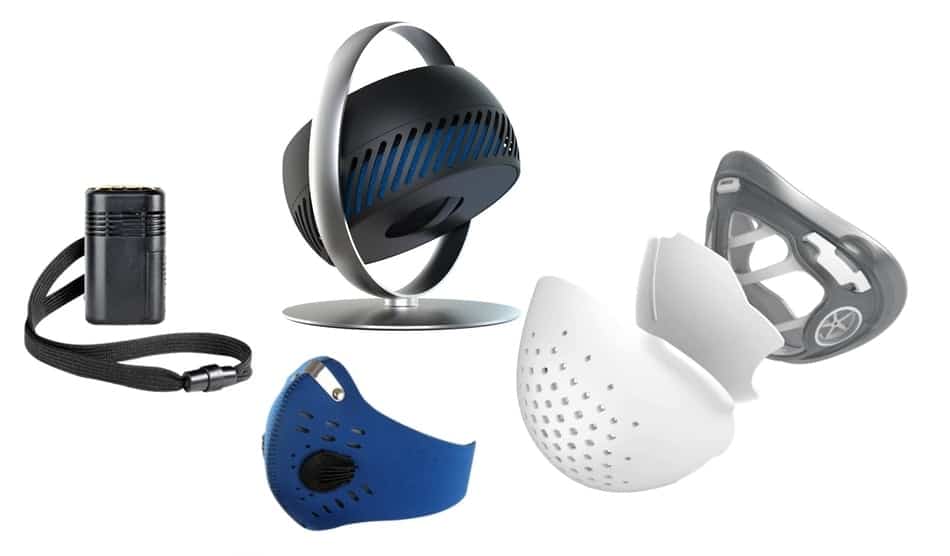
My wife and I recently started traveling and if there is something that we have become increasingly concerned about on our trips it’s our air quality. Whether it’s in your hotel room, or when you are on the go in your car, in the airplane or on the train, or simply at the office, polluted, dry or humid air can cause you a myriad of discomforts.
One moment you are enjoying your trip and the next your nose dries up and bleeds, you get sinuses and unexplained allergic reactions, or you just find yourself having to deal with a stuffy and smelly room.
These things have happened to me and my wife one too many times. As a result, to minimize the chances of our lives’ and health getting disrupted by poor air quality when we are out and about, I decided to search online for a good air purifier I can use when I am on the go.
I found a diverse range of options and I have categorized everything I found for you here if you are on mission to breathe clean air.
So what are the different types of personal air purifiers available? Personal air purifiers can fall into two broad categories namely wearable air purifiers and portable air purifiers. The two broad categories can be broken down further into eight sub-categories. The eight sub-categories include:
- Filtered Personal Air Purifiers
- Filterless Personal Air Purifiers
- Table or Desk Air Purifiers
- Boat and Car Air Purifiers
- Combo Personal Air Purifiers
- Airplane and Necklace Air Purifiers
- Nasal Air Purifiers
- Air Purifier Masks
As you might have guessed the last 3 types of purifiers on the list are wearable and the rest are portable air purifiers. The 2 broad categories are distinct but you find overlaps between the sub-types. More precisely all wearable, combo, desk, and vehicle air purifiers can be either filter based or filterless.
However, it’s important to classify these features and use cases separately so that you don’t end up getting the wrong device as a result of missing the information on the unique attributes of each category. For example, a portable desk purifier may not work as well in a car if it is designed with unique features specifically for use on your desk.
So now that you know the sub-categories of personal air purifiers, we are going to look at each type in more detail. But before we do that, let’s start with a brief description of what personal air purifiers are and look at when they are effective and not.
This is merely so you have a deeper understanding of whether you really need a personal air purifier. If you are in hurry and don’t have time to read everything you can just skip around the different types of personal air purifiers that interest you by using the quick navigation table.
What are personal air purifiers?
The most complete definition I can give you of personal air purifiers is that they are portable devices that eliminate pollutants in the immediate air around you while you are on the go. Personal air purifiers are air purifiers that you can easily carry with you and use almost anywhere.
They are designed for use within close proximity of your body. Modern personal air purifiers are increasingly becoming smart devices that can connect to the internet and give you real-time feedback about how they are performing and about your air quality through an app or monitoring tool on the device.
These devices enable you to breathe cleaner air both while you commute and in private spaces away from home such as your cubicle at work or in your tent while you are camping to list a few examples. They clean air that’s within a range of up to 600 square feet around you by getting rid of airborne viruses, allergens, volatile organic compounds (VOC’s) fumes, odors, and the list goes on.
Do personal air purifiers work?
From my research, I can safely say personal air purifiers do work but there are a lot of poor products with big claims out there and you need to be very careful when you are finally getting yourself one. The biggest controversy surrounding whether personal air purifiers work or not is around necklace air purifiers designed for use while traveling and on airplanes.
Necklace air purifiers work by emitting a stream of ions around the person wearing them which stick to pollutants in the air making them heavier and eventually making them fall to the ground. This process is where experts question their effectiveness.
Research has found ionizer based personal air purifiers produce ozone which is harmful in large quantities and actually irritates your lungs and eyes. Besides producing ozone, some experts say the necklace air purifiers are not big enough to produce enough ions to clean pollutants from the air at an acceptable rate. Some have applied this argument to other types of portable air purifiers as well.
Various personal air purifiers have been tested, by Consumer Reports, the California Air Resources Board, and the Federal Drug Administration and their lab tests show that ionizer based devices help clear a variety of test particles from the air, but researchers say it’s hard to tell if these devices have any health benefit in real conditions. What’s more, when you are on the go, there are many harmful germs transferred via infected surfaces and air purifiers cannot help in such cases.
The other major concern I found for airplane personal air purifiers was that some airlines do not allow them. So if you get a purifier to use during your flights, depending on your airline you may find when you get on the plane that you cannot use it. This is true mostly for US airlines, because of an unfortunate incident on a Continental Airlines flight in 2006 where a passenger’s air purifier caught fire and the pilot had to make an emergency landing.
I failed to come across independent scientific evidence that found that necklace air purifiers work with no doubt but there is a lot of research done by purifier distributors showing their devices work. For instance, Cometech Research, the distributor of the AirTamer personal purifier say they looked at other personal air purifiers and all they found was junk until they found the Air Tamer.
Like independent scientific findings, they found some devices emitted ozone and even adverse positive ions while their device cleans up to 110% more pollutants than the competition cleaning 99.01% of pollutants in the air. They also say they found that their device’s ozone output is undetectable.
Though I did not find any independent studies supporting personal air purifiers as effective means of cleaning your air, I did find a lot of anecdotal evidence. So much to the point, I am left convinced that these devices are helping a lot of people. My final say from my findings is that all air purifiers have their shortcomings and do not on their own entirely protect you from pollutants.
For me, the purpose of a personal air purifier is to reduce inhalation of bad air and minimize the effects as much as possible. The aim should be to get the best possible device you can find and afford while at the same time making sure you take other hygiene measures to prevent catching communicable diseases transmitted through germ-filled surfaces and air.
In finding good devices for personal use, you should stay away from ionic or electronic air cleaners that emit harmful levels of ozone. You can do this by looking at device ozone emission test results before you decide to buy them.
A lot of resources I have gone through also recommend purifiers that have activated carbon filters if you go the filter route.This is recommended especially if you are looking at getting a portable air purifier as these do well in dealing with odors beyond just getting rid of harmful air particles.
There is so much more I can say here but the bottom line is that personal air purifiers do work. The biggest challenge, however, is finding the right device among many substandard ones.
Now that you understand what air purifiers are, and the general situations in which they work and don’t work, let me take you through the different types of personal air purifiers in more detail.
1. Filtered Personal Air Purifiers
Filtered personal air purifiers come in many forms and you will find them across all the types of air purifiers (personal and general). Most personal air purifiers have either a HEPA (High-Efficiency Particulate Air) filter or an activated carbon filter or combination of the two. HEPA air purifiers work by trapping airborne particles through the exclusion of given particle sizes.
They rid the air of small and large solid particulate matter such as pollen, mold, dust, and bacteria. On the other hand, activated carbon filters work by absorption. They absorb volatile organic compounds, ozone and a number of gases on a molecular basis and unlike HEPA filters are able to effectively remove odors while they fail to trap large particles.
HEPA, filters were originally made to remove radioactive particles from the air. They are made from finely intertwined glass particles which are put together in a pleated filter with a very large surface area. The larger the surface area of a HEPA, the better, so look out for devices with higher square footage when comparing options.
Taking note that the smallest particle visible to the human eye is about 50 microns, HEPA filters are able to remove 99.97% of all 0.3-micron particles from the air. However, they are quite costly to maintain. In most personal air purifiers they have to be replaced at least once every 12 to 18 months, at a cost ranging upwards of US$50.
HEPA filters also use a lot of electricity because their filters are so dense and need a strong blower for air to flow through them. HEPA air purifiers have been studied extensively, so when you find a suitable device make sure to check if it is certified as an approved device on institutional databases such as the California Environmental Protection Agency’s Air Resources Board to ensure.
Activated carbon air purifiers come in handy if you are mainly concerned about getting rid of odors and they also absorb sulfur and rid your air of fart smells. Beyond VOCs, some of the important gases activated carbon filters are good at eliminating include cigarette smoke, paint or cleaning product fumes, benzene, toluene, xylene, chlorinated compounds, and the list goes on.
HEPA filters can be combined with carbon filters to capture VOCs and eliminate odors, gases, and VOCs in the air. The only limitation is that the carbon filter increases the pressure needed to suck air across the air purifier and hence requires a strong fan power and consumes more electricity. Carbon air filters remove many organic compounds from the air, but they don’t deal with every type of odor with wildfire smoke being among the most common pollutants people mistakenly think activated carbon can get rid of.
You should also note that activated carbon purifiers merely change contaminants from their gas state to a solid state. As a result, contaminants can re-enter your airspace if you carelessly tamper with the filter.
Like HEPA filters replacing activated carbon filters is also a costly exercise and worse yet, it is hard to tell when to replace your carbon filter as there are no visible signs when it is fully saturated. Most of the times you have to guess or do scheduled annual replacements regardless of whether your filter is saturated or not.
To get a better air purification experience, activated carbon filters are normally combined with other filter technology, especially HEPA filters. The only inadequacy with such air purifiers is that they consume energy as the extra carbon filter layer requires stronger fan power to maintain good airflow in the given device.
My final take on filtered personal air purifiers is that they are best suited for larger portable personal air purifiers that you can use in your cubicle, office or hotel room. Some portable filter based air purifier devices are also good for use in cars, boats and baby strollers or prams.
2. Filterless Personal Air Purifiers
There are several types of filterless air purifiers on the market and these also come in both wearable and portable form. The most common filterless personal air purifier technology you will find are Ionizers. Other technologies include Advanced Hydration Photo-Catalytic Oxidation (AHPCO), Thermodynamic Sterilization (TSS), Ultraviolet Purifiers and Biotechnology Purifiers.
Ionizers
Let us start with Ionizers. Ionizer-based devices purify the air by using charged electrical surfaces or needles to produce electrically charged negative ions in the air.
These ions then stick on to airborne contaminant particles which are then electrostatically attracted to a charged collector plate or the particles just fall to the ground if your device does not have a collector.
The process is called ionization and it results in trace quantities of by-products such as ozone and other oxidants. Below is a diagram of the ionization process and pictures of an ionizer.
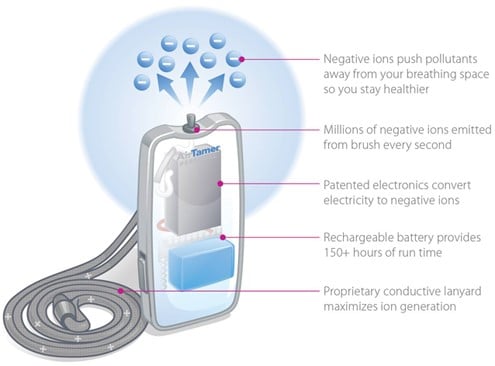
Ozone is harmful and can irritate your eyes and throat if your ionizer releases too much of it. So when you are getting an ionizer, make sure the specs indicate that it generates less than 0.05 ppm (parts per mile) of ozone as recommended by industrial safety standard guidelines.
Ionizers come in two main forms, namely fan-based and fan-less ionizer. Fan-based ionizers generally distribute and clean air more efficiently than fanless ionizers while fanless ionizers are more silent and consume less energy than fan-based ones.
As they emit ozone which may trigger reactions among people with severe allergy problems, Ionizers are better for use in private spaces like a private office or your car or when you are out hiking or jogging on your own if you get a wearable one. Good personal ionizers will cost you anywhere in the range of US$12 –US$500 depending on the size and use case of the device.
AHPCO Air Purifiers
The next type of filterless purifier is an AHPCO purifier. It is a technology developed by NASA and adopted and enhanced by air purifier manufactures. This type of purifier is known for its silent operation.
Research shows AHPCO purifiers do a better job than HEPA air purifiers as they actually destroy contaminants rather than just trap them. AHPCO purifiers are also more energy efficient than most purification systems.
They clean air both within and outside the purifier unit. Air that enters the system is exposed to an AHPCO cell which consists of titanium dioxide and UV light that produces harmless oxidizers such as hydroxyl radicals and hydroperoxide (these are disinfectants).
Then through catalytic oxidation, the oxidizers destroy carbon-based molecules which include odor causing VOCs, smoke, mold, bacteria, viruses and other allergens in the air.
The oxidizers formed in the purifier are also released into the air by the unit and destroy pollutants not only in the air but also on surfaces within your room through oxidation. You can have a look at the Air Oasis AA250NGFU Air Angel Air and Surface Sanifier at Amazon here as a great example of an AHPCO air purifier.
An AHPCO purifier will cost you anywhere between US$200 and US$500. With regards to personal air purifiers, this type of personal air purifier is only available as a portable device and is best suited for use on your desk or in rooms with a power outlet.
It is a relatively new technology and research is still being done to determine if AHPCO purifiers release any dangerous by-products but so far the technology has proven harmless to the environment or humans.
Thermodynamic Sterilization
Next, we have TSS purifiers. This type of purifier works by heat sterilization. It entails heating a ceramic core with microcapillaries to about 200 °C (392 °F).
Using air convection, the air then passes through the heated ceramic core, and afterward cooled using heat transfer plates and released back into your environment fresh and sterilized.
TSS purifiers do not trap or remove particles like filtered purifiers do but rather destroy pollutants by burning them. A great TSS personal air purifier you check out at Amazon is the portable Air Free P1000 Purifier.
Here is an illustration of how TSS purifiers work.
This technology apparently incinerates 99.9% of microbiological particles including mold, bacteria, viruses and various allergens among other pollutants and also reduces the concentration of ozone in your atmosphere.
It is claimed TSS purifiers do not emit harmful by-products but research is being conducted to test if they release any harmful thermal decomposition by-products.
TSS purifiers will cost about US$90 – US$400. They consume a lot of energy and need to be plugged into a socket so the best place for this type of personal purifier is when you are on the move is in a hotel room, on your desk or anywhere where you won’t knock it over or move it around as it operates.
UV Air Purifiers
Ultraviolet purifiers clean air by concentrating UV light on air particles to kill mainly mold and bacteria. In the process, high-intensity germicidal UV (UVGI) light is used to disinfect air through prolonged exposure.
Disinfection depends on how long air is exposed to the UV light and intensity of the UV light. As a result, UV purifiers are not as effective with moving air, or when the lamp in a device is perpendicular to the air flow because this seriously decreases exposure time. An example of a personal UV purifier you can find at Amazon is the MINLUK UV Sterilizer.
UV purifiers can be either free-standing units with covered lamps or be placed in other types of air purifiers but whichever form they are in, they have to be placed in a system where the air is forced toward the UV lamps for exposure. Good UV purifiers also contain a filtration system that removes dead microorganisms.
If you go for a UV based personal purifier, go for combo devices with a UV lamp positioned next to the drain pan and coils of the system as this prevents microorganisms from forming naturally around damp areas of the device.
UV purifiers are a more flexible types of personal air purifiers and can be used in a variety of wearable and portable applications. Good portable UV based purifiers will cost you anywhere between US$50 and US$900.
Biotechnology Air Purifiers
Biotech air purifiers have been under research for the past 30 years and are a relatively new type of purification system. In fact, I only managed to find one company with the produces this type of purifier and its called U-Earth.
Their air purifiers combine the basic scientific principles of convection, molecular charge attraction and natural oxidation to trap and destroy both pollutant particles and odors in the air of any particle size. U-Earth calls this process BioHygienics.
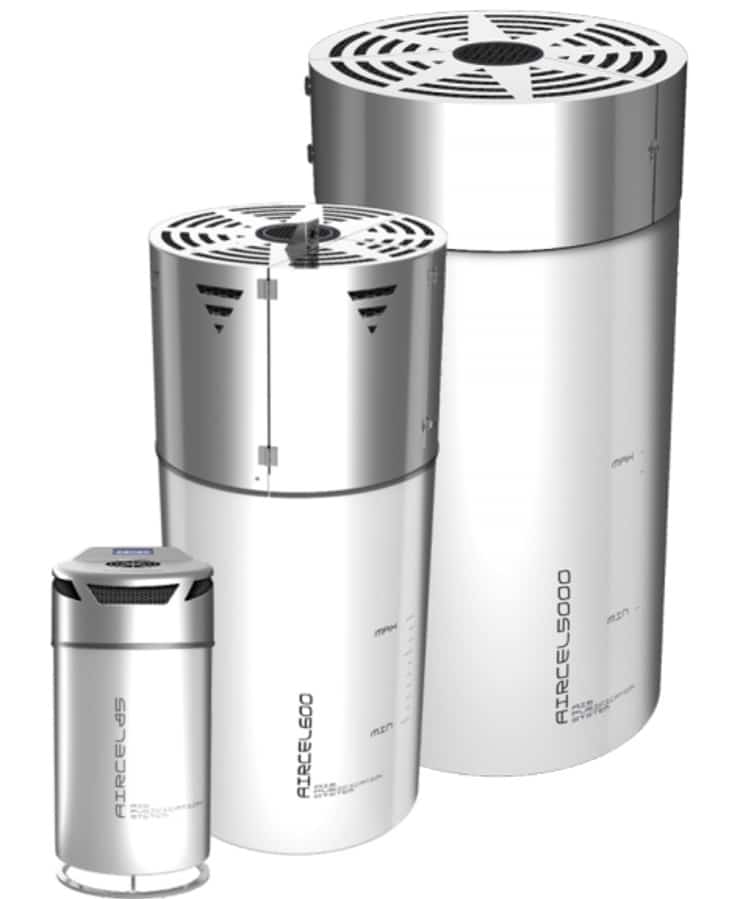
Large particulate matter of over 0.5 microns in size which make about 10% of pollutants in the air is sucked in and trapped by bioreactors in the purifier through convection using a ventilation system.
Then molecular charge attraction which happens on the electrically charged bioreactors further traps both positively and negatively charged contaminant particles in air consisting of volatile organic compounds (VOCs), gases, ultrafine particles and more which make up 90% of air pollutants and cannot be completely trapped by ordinary ventilation based purifiers.
Once the contaminants are trapped, a process of natural oxidation begins in the system through enzymes and microorganism in the bio-reactor which digest and break the contaminants turning into water, carbon dioxide and base elements leaving you without the problem of waste disposal.
This technology has been applied to portable air purifiers and wearable air purifiers (discussed later in this post).
U-Earth claims its portable air purifiers are very effective in eliminating odors and mold in boat cabins and yachts and that their devices can be used in a setting where you can plug into an electrical power supply. I failed to find the cost of portable biotech personal air purifiers but their masks cost about US$40.
3. Desk Personal Air Purifiers
I have seen so many personal air purifiers for desks and table tops that I now think they are likely the most widely available type of portable air purifier. They come in both filtered and filterless form and most can be recharged and powered using both a USB port and a socket.
Desk air purifiers prices range anywhere between US$10 and US$1000. If you are looking for a device for a private office desk, you have many options but if you want something for a cubicle there are some devices that are just not convenient for open plan spaces so your choice is more limited here.
To begin with, I think the best purifier for an office setting would be a well-sealed True-HEPA filter combined with activated carbon. This will ensure you not only particle filtration but also absorption of bad odors and gasses around your desk and cubicle.
For extra hygiene, you could into purifier that also has an UltraViolet sanitizer that kills germs within the filtration system. Next, because you are in public environment your office air purifier first and foremost, needs to be as silent as possible.
So avoid purifiers with a loud hum. Also look for an easy to maintain purifier that doesn’t need frequent filter changes to avoid unnecessary downtime at the work. You must also account for potential health issues if your desk is in an open space.
This means you will want to stay away from ionic purifiers because the ozone they generate might just cause health irritations in some people especially if any of your co-workers have allergy issues or asthma.
So ozone generators are a definite no-go area and your best bet is to stick to a HEPA air purifier. In terms of size, a good rule of thumb for desk air purifiers is to go for a device that is designed to cover at least 300 square feet.
Some good air purifiers to use on your desk include the Wynd Air Purifier and the Humanscale Zon Air Purfier. Check out my post here for a more in depth guide on office desk and table top air purifiers.
4. Boat and Car Personal Air Purifiers
Most boat and vehicle air purifiers are ionizers or HEPA filters or a combination of the two. We have already explained how each technology works and with car air purifiers the form in which they come is the most important distinguishing feature.
Car ionizers typically cost between US$10 and US$400 while car HEPA filter air purifiers range between US$30 and US$600. The Wynd Plus air purifier mentioned above for desk use also serves as a good car air purifier.
Ionizer car air purifiers come in a form that can be plugged into your vehicle’s 12V cigarette lighter slot and this powers them up to produce negative ions which combine with pollutant particles and neutralize them making them harmless.
If you go for a car ionizer be careful to select one that produces negligible levels of ozone. Here are some pictures of car air ionizers.
After watching some YouTube tests, my conclusion on car ionizers is that they work to an extent but they are not big enough to generate enough ions to effectively provide you with clean air in your car. Check out the video below.
The other thing with car air purifiers is that, every time you open your car window you have to start the purification process from scratch. On top of this ionizers don’t work when your car is off and you always come back to a polluted car.
What’s more, neutralized pollutants from ionizers fall over the inside of your car and live a film of dust around your car’s interior which you constantly have to clean up.
Accordingly, I think you can achieve better air purification in cars using a HEPA filter and preferably one that’s combined with an activated carbon filter.
These usually come shaped in a form you can easily place within your car’s cup holder or on your dashboard and they can be charged and powered using a USB cable in your car.
You also get some car HEPA filters combined with both an activated carbon filter and negative ionizer. But because of the mess ionizers may leave behind I personally would rather stick to filter based purification in my car.
If you just want to freshen the air in your car, you can use a portable battery powered ozone generator while you are not in the car but to avoid the health risks you have to know how to use ozone generators properly.
If you don’t know what you are doing, you would rather not experiment with ozone generators. You will notice I have not mentioned boats yet. This is because the same principle with car air purifiers applies with boats and yachts though you would want to also consider dehumidifiers for moisture control.
Boat enthusiasts also swear by ozone generators but again be very careful with ozone. Others recommend also using a good dehumidifier together with HEPA and activated carbon air purifiers to avoid and deal with commonly occurring mold and odors.
Another option to explore for boats are portable biotechnology air purifiers. If you would like to find out more about car air purifiers, click here for more detailed post on car air purifiers.
5. Combo Personal Air Purifiers
Like filtered and filterless air purifiers, combo air purifiers cut across both the wearable and portable category of personal air purifiers. Combo air purifies are normally a 2 in 1 device that is a combination an air purifier with another air improving device such as a dehumidifier, diffuser, air cooler or humidifier to mention a few.
If you want to eliminate extra moisture while getting rid of pollutants you can get a portable dehumidifier air purifier combo unit while to create extra moisture you go for a humidifier and purifier combo unit.
Such portable personal air purifier units work well for spaces of up to 600 square feet and are best for use in your private vehicle, within your cubicle at work, in a tent while camping or any small covered space where you spend time.
As for combo wearable air purifiers, the ones I have seen are mainly come combined with either a diffuser and or humidifier.
If you are wondering about the benefits of getting a combo air purifier, I think the main benefit has got to be that you spend less money by getting one device that does the job of 2 devices at the fraction of the cost of getting these devices separately.
Something that may be of less concern is that having one device saves you space and is less cumbersome when you are on the go.
Depending on which combination of devices you get, you can also benefit by being able to use one device throughout all the different seasons of the year without the burden of putting away and unpacking separate device.
However, having 2 devices in 1 usually compromises on the performance of each function. A humidifier and air purifier combo will either lean more toward a purifier or humidifier.
So if you want a fully performing uncompromised air purifier you would rather go for separate machines over combo units.
6. Airplane and Neck Air Purifiers
When I was looking into airplane or neck air purifiers, I found two types of neck air purifiers namely filterless and filter neck air purifiers. Though I have seen one with a filter, most of the neck air purifiers I have come across have no filters to change and come ready to use on the go.
They are quite handy devices whether you are on the plane, in taxis, in buses, at the gym, crowded elevators, in the office, or anyplace you need your device. However, you have to be cautious when you carry these devices on the plane because as I discussed in detail earlier in this post, some airlines don’t allow them and will confiscate your device.
All the filterless neck air purifiers I have come across are ionic air purifiers which emit ions to create your own personal air purified zone.
They cost about US$60 on average and are normally silent and fan-less and made of maintenance-free technology that you can attach around your neck with a lapel or lace.
They are designed to lower your risk of inhaling toxic particles and allergens by reducing your breathing zone concentration of pollutant particles. Here are pictures and videos of two varieties of filterless neck air purifiers.
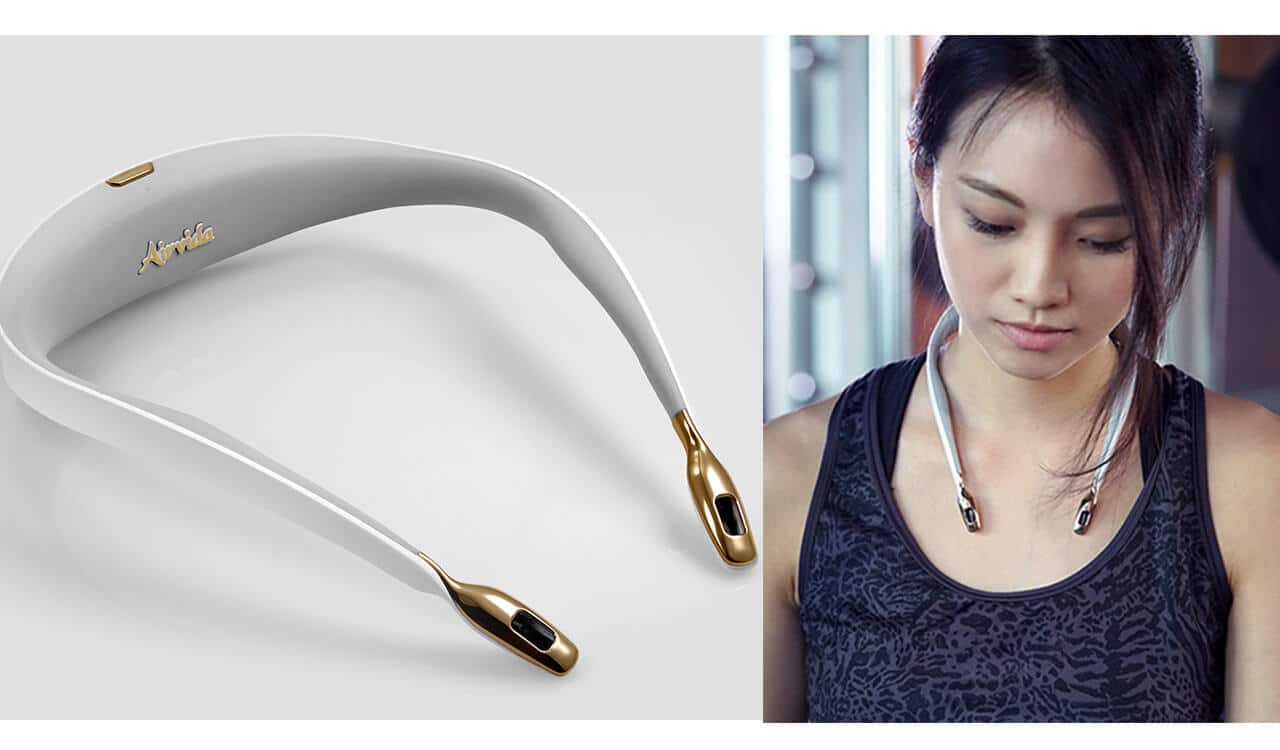
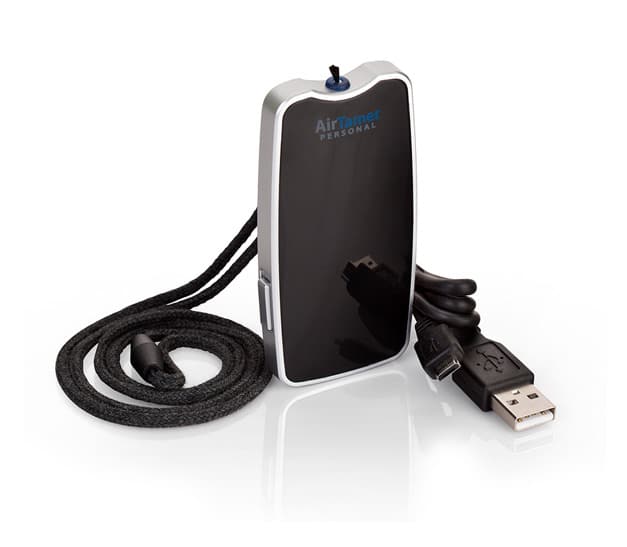
Some are powered by built-in Li-on rechargeable batteries while others come with replaceable AA or AAA batteries. The rechargeable type comes with either a power cable or USB cable or both to allow you to charge the device.
I have read client reviews where some people complain about their weight but normally these are lightweight devices designed for you to carry around your neck for long periods and average about 60 grams in weight. If you use your device often a good ionic neck air purifier should last you for at least 2 years.
As for the filtered neck air purifiers, I came across the Hyundai portable purifier which claims it’s the smallest HEPA filter air purifier. It costs about US$170. Here are is a video of the Hyndai filtered neck air purifier.
I am sure this is not the only filtered neck purifier on the market but I failed to come across others. This particular type of neck purifier weighs more than the ionic type at about 230 grams.
It’s much heavier the ionic filterless type as it has both a HEPA filter and a negative ion generator but it’s still light enough and easy to carry around your neck. Just like this device, I imagine most filtered neck purifiers come with a rechargeable lithium-ion battery and chargeable using a USB port.
Like larger HEPA filter purifiers, neck purifier filters are replaceable. Some like in the example here also come with a slot to insert essential oils. Filtered neck air purifier filters last about 3-4 months depending on how often you use your purifier.
If you decide to go for any neck air purifier, here are a few things to note.
This type of personal air purifier is redundant for use on an airplane, as most planes now have on-board air cleaners which completely change the cabin air every two to three minutes anyway.
If you decide to use it on an airplane anyway, use one with an air purifying mask as well to better protect yourself.
Whatever purpose you get this kind of air purifier for, get one that is rechargeable by USB so you don’t have to keep buying batteries. Finally, because of their small size do not expect these devices to work wonders like getting rid of pet dander, or all sorts of odors in a room.
Neck air purifiers only reduce the chances of you being harmed by pollution and do not provide complete protection from pollution. Look for the best device you can find but also run away from companies that claim that their device offers full protection pollutants.
7. Nasal Air Purifiers
According to scientists, about 90% of the air you breathe goes through your nose. Accordingly, some companies have gone for air purifier designs that directly stop you from breathing bad air through your nose.
Such devices are called nasal air purifiers and they work by inserting filters into your nostrils or covering your nostrils with some form of filtration material.
I have seen a wide variety of nasal inserts and they are quite similar but nasal covers come in two distinct forms. Nasal covers come either as a nose only masks or as a screen you can seal around your nostrils as you can see in the pictures that follow below.
Best Breathe Nasal Filters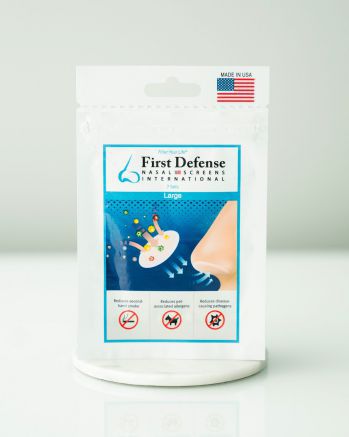
First Defense Nasal Screen
Nasal air purifier inserts are designed to improve your intake of clean air through your nose in a safe and comfortable way. They cost anywhere from US$40 to US$100 and just like the necklace air purifiers their role is to reduce exposure to pollutants rather completely protect you.
A good nasal insert will reduce exposure to allergens such as pet dander, dust, pollen, mites and pollutant particles that are larger than 20 microns. However, they won’t really help with odors and many gases.
Nasal inserts come in various standard sizes and if you have the right size you don’t need to worry about the falling out or causing you discomfort. They don’t deteriorate as a result of perspiration but you have to replace their filters every 24 hours.
Nasal masks are similar in function to nasal inserts. The main difference is that you don’t have to change their filters as often and they use a strap around your head to latch on to your nose which has a high chance of being uncomfortable if the device is poorly designed.
Also, there are high chances of pollutants leaking through if the device does not fit or latch on properly. I personally think the best option when it comes to nasal air purifiers is nasal screens.
They cost about US$9 – US$100 depending on which pack size you order. Nasal screens are designed to self-adhere to the rim of your nostrils and completely seal your nostrils with no opportunity for pollutants to leak through.
They are made of hypoallergenic filter like material that does not obstruct your ability to breathe but filter out and significantly reduce the number of pollutants you inhale.
They are self-cleaning so they won’t clog up but they have to be replaced every 24 hours. A good brand of nasal screens should be friendly to your skin, able to prevent you from inhaling dust, pollen, silica, respiratory droplets, and similarly sized pollutant particles.
My final thoughts on nasal air purifiers are that they are good for people on the move, whether you are playing sports, traveling or at the office with the obvious exception of the nasal mask because it’s rather intrusive (I might as well put on a full mask).
Also, I think nasal inserts and screens can get quite costly because you have to replace them every single day. You can have a look at the First Defense Nasal Screen at Amazon for more details on actual costs.
Nevertheless, all nasal air purifiers have the advantage of allowing you to talk and eat as opposed to masks which you have to pull on and off. That said if I was OCD or in China, I think I would use a nasal screen together with a mask and necklace air purifier wherever I go.
8. Air Purifier Masks
The final category of personal air purifiers we are going to look at are air purifier or anti-pollution masks. Anti-pollution masks have historically been developed for military and medical use to protect soldiers and health workers against poisonous gases and airborne disease outbreaks.
Accordingly, they are the most well researched and widely known category of personal air purifiers and in my view the most practical solution for people on the go but unfortunately I don’t see military grade gas masks being sold to the public.
I guess it would probably be hideous if we all walked around in military gas masks but that would be all you need right? Anyway, in my research on consumer air purifier or pollution masks, I found a galore of products but they all fell under two categories of purification technology.
All the anti-pollution masks I found were either ventilation (also known as respiratory) or biotechnology-based air purifiers.
Most anti-pollution masks you will find are ventilation based and like for HEPA filter necklace air purifiers, I only found one company that makes biotechnology-based pollution masks.
Let’s start with ventilation masks. These come in all shapes, sizes, and branding. They are also quickly become high fashion items with numerous designer brands. You can even get an anti-pollution mask for your dog now.
Ventilation based anti-pollution masks work by covering your mouth and nose with a form of filter material so that when you inhale, dangerous airborne particles are trapped in the filter material before they can get into your body through your nose or mouth and harm you.
You normally latch these on your face to cover your nose and mouth using straps around your head or you could get them as a balaclava.
Some masks have built-in filters and you have to replace the entire mask when its useful life ends (typical every year) while others come with replaceable filters or valves that you can change every 1-6 months depending on usage.
Most brands offer filters that can be taken apart and cleaned. If you have a washable mask, you can clean the inside and outside of the mask with warm water but avoid any harsh cleaning products. The price of ventilation based pollution masks range from as little as US$1 to about US$300.
There is a lot of debate surrounding the effectiveness of consumer anti-pollution masks because of the proliferation of companies making them and many masks have been found useless after being tested.
So if you are getting an anti-pollution mask, especially in the US and Europe, to make sure you are getting a high-quality mask check if your mask has either an N95 or N99 certification.
These government issued ratings show the percentage of air particulate matter a mask can filter with an N95 rating showing you that your mask can protect you from 95% of particles and an N99-certified design showing you that you are protected from 99%.
Here is an interesting chart showing the effectiveness of different brands of masks and their prices.
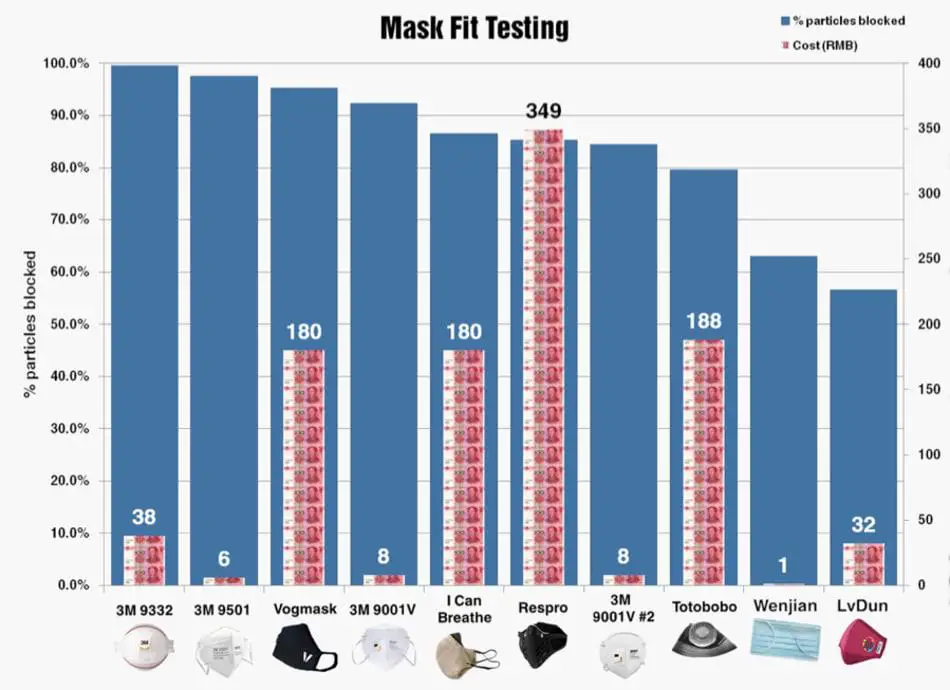
Source: Quora, Thomas Talhelm
The chart shows that higher prices do not necessarily mean better quality and an unsuspectingly low priced 3M mask performed better than the most highly priced designer mask.
So based on this chart the only reason you should be going for an expensive designer mask is if you value fashion and style beyond getting the purest air possible. Another good source with detailed research on air purifier masks worth looking at is Dr. Cyr’s pollution mask fit test .
This study does not test every single pollution mask brand and obviously is not conclusive on the performance of all brands but it is eye opening if you are searching for a mask that will best protect you.
When considering a ventilation based pollution mask also look for masks that can filter out PM 2.5. PM 2.5 particles consist of the tiniest and most dangerous types of pollutants which can pass into your bloodstream and stay in your lungs for a while but unfortunately, most masks fail to filter them out.
So if you go for ventilation based masks look for masks that have sub-micron filters as they remove the most types of particulate matter from the air including PM 2.5 particles. Also note that your mask has to be snug and tight fit on the face to prevent leakage and to work effectively.
I think I have said enough about ventilation based masks. Now let’s discuss biotech pollution masks.
As I mentioned earlier I only found one company that offers biotech masks and the company is called U-Mask (see a picture of the mask below). These masks cost about US$40.
Biotech pollution masks are different from the common ventilation masks which are dependent on how well they fit and prevent leakage to be effective. Biotechnology masks stop polluting particles by attracting them through electrical molecular charge and not by ventilation. Check out the picture below for a better understanding.
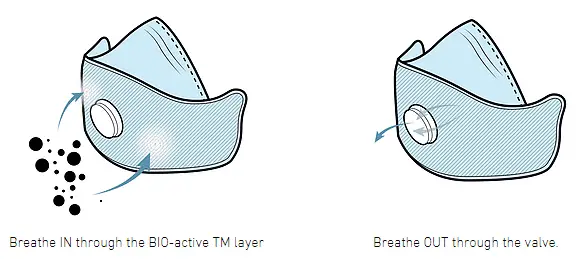
Biotech masks have an electrostatic layer where pollutants get trapped as you breathe and once the pollutants are trapped, they are destroyed by another bio-activated layer containing harmless microorganisms which use the moisture from your breath to decompose and destroy the contaminants by bio-oxidation.
With biotech masks, you do not need to worry about leakage because the masks electrostatic field is able to attract the contaminants before you inhale them even if they manage to get on the inside of your mask. What’s more, you are not walking around with germs and contaminants trapped near your face as they are eliminated on the go.
The masks electrical molecular charge attracts ultra-fine particles like a magnet attracts iron dust and it can filter particulate matter as small as 0.1 microns while ventilation based masks only filter up to 0.3 microns.
The challenge with biotech masks, however, is that they have a chemical odor which can unpleasant but it’s bearable and if you wear glasses or motorcycle helmet expect them to fog up as you breathe because the masks are designed to generate moisture to get their bio-active layer working.
Overall I find that pollution masks are by far the best wearable personal air purifiers around from a protection perspective. While biotech pollution masks claim to better protect you than ventilation anti-pollution masks, you have way more design variety and choice with ventilation based masks.
No matter how good your type of pollution mask is, it can’t keep everything out. Some gas particles or cigarette smoke, for instance, are extremely small and are just too difficult to stop through any typical consumer mask.
Normal civilian masks also won’t entirely protect you against viruses and diseases but rather just act to reduce your chances of catching something from the air. Most manufacturers put a disclaimer on their masks stating that they won’t protect you from,
“chemical vapors or gases, oxygen-deficient atmospheres or high-risk exposures such as those created by aerosol-generating procedures”.
On the upside, pollution masks not only protect you from some odors and dangerous airborne particles when you are on the move but hey also provide you with some warmth in winter.
Although they can be uncomfortable their health benefits far outweigh their discomfort they may cause. Try doing before and after pictures of your masks filter after wearing your mask for a week through heavy traffic and you will never look back on using masks.
If you would like more information on masks, check out my masks resource page where I guide you on which anti-pollution mask to get and where to get your masks.
Final Remarks
This was quite an intense overview of the different types of personal air purifiers out there but I am sure there are other types of purifiers I have not covered. If you have come across any type I have not touched on please do share in the comments below.
On my final thoughts, I can say the most important thing I learned going through the various purifiers is that none of them can guarantee you completely pure air but all of them rather serve to reduce the amount of contaminants you breathe in.
This research has made me more paranoid about my air but also made me confident that I can protect myself from pollution when I am out and about.
I hope you found this information helpful and that you found a better way to protect yourself from bad air as well.
Let me know in the comments which was your favorite type of personal air purifier and feel free to drop me any relevant questions and I will get back to you soonest.
Information Sources
WSJ – https://www.wsj.com/articles/can-personal-air-purifiers-keep-cold-and-flu-bugs-away-1426523645
Bleed Free – http://bleedfree.eu/wp-content/uploads/2015/10/Final-Report-to-AOA-02-06-2002.pdf
Tree Hugger – https://www.treehugger.com/culture/ask-treehugger-portable-air-cleaner-considerations.html
NCBI – https://www.ncbi.nlm.nih.gov/pubmed/15982270
Taylor & Francis online – https://www.tandfonline.com/doi/pdf/10.1080/02786826.2016.1139045

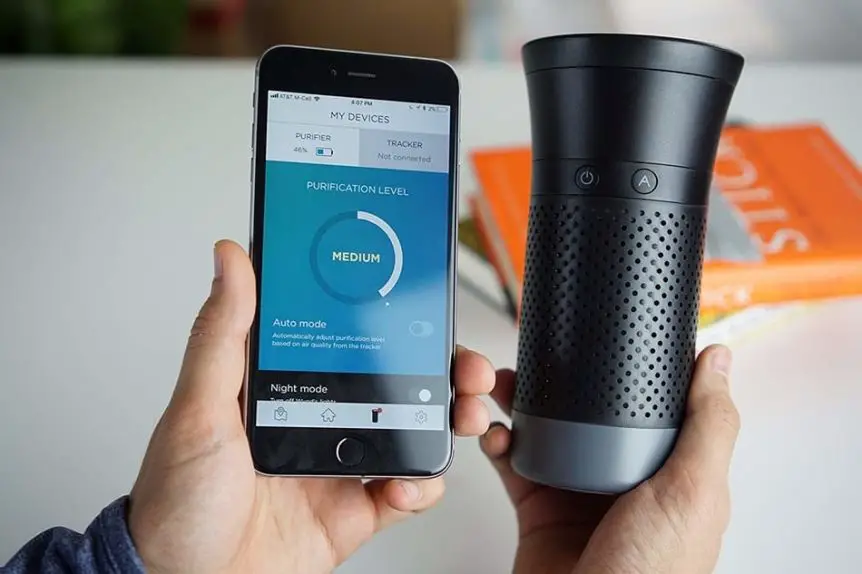
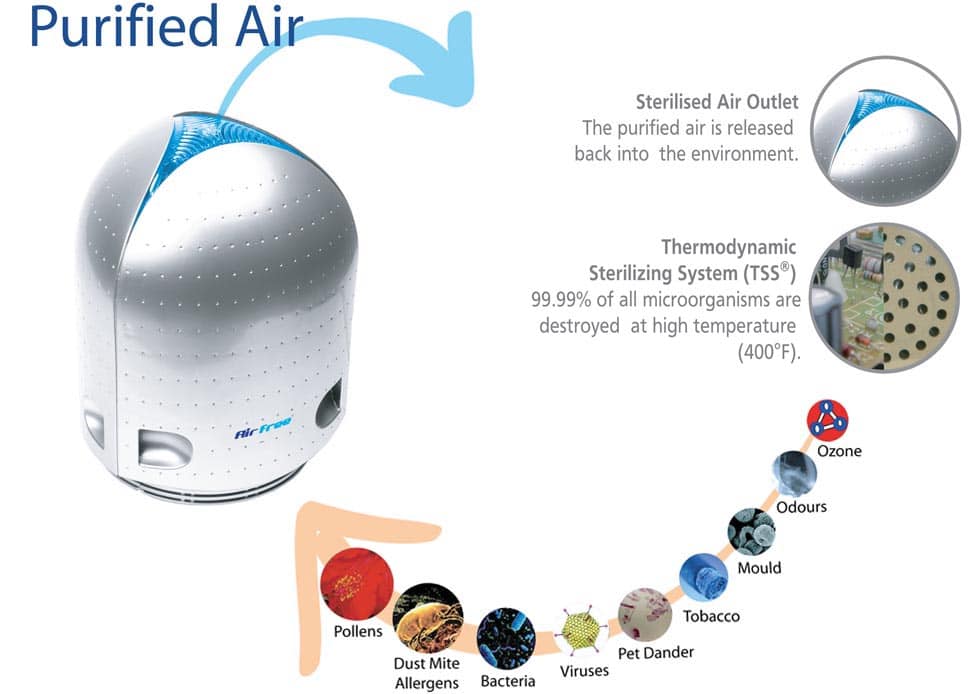
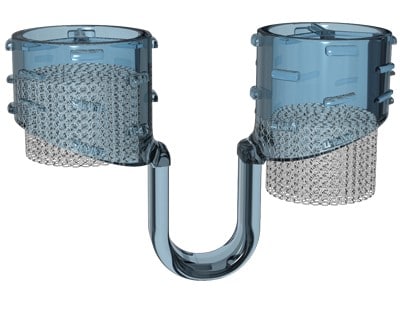
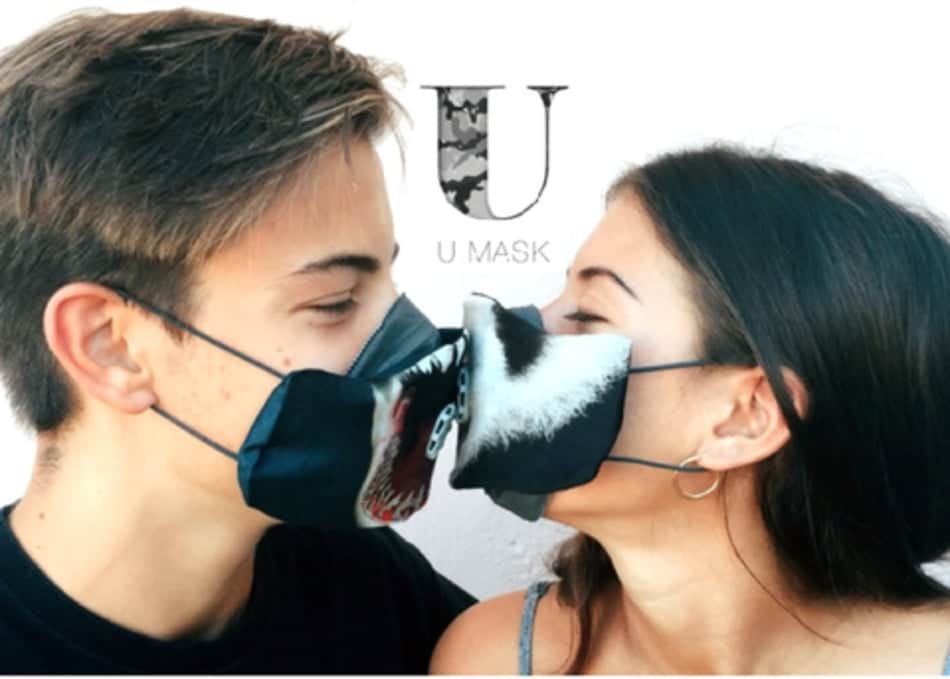
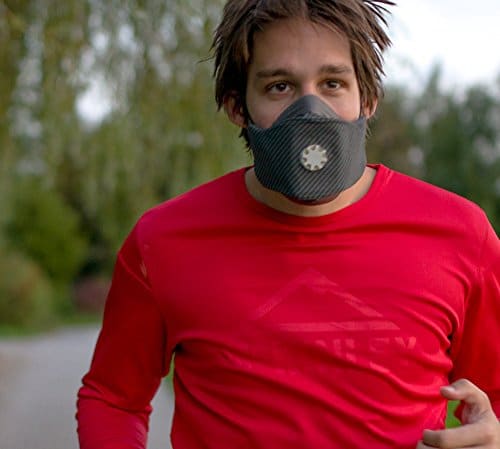
Comments
You have covered quiet a bit of wearable and portable air purifiers I would suggest that you should recommend some wearable air purifiers that produce very negligible Ozone in compliance with FDA and Environmental Protection agency. In fact, I am looking around for wearable ones myself. Thanks.
Thanks for your comment Romulo. I am yet to come across an FDA approved wearable air purifier. As soon as I find one I will definitely add it to my recommended gear.